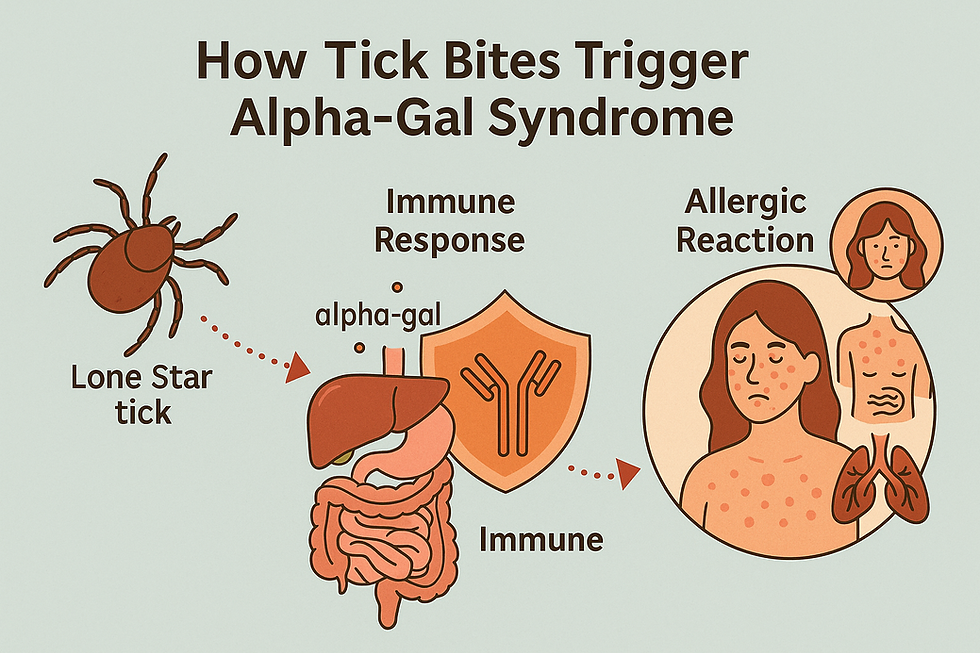🧬 Why Alpha-Gal Syndrome Cases Are Increasing Across the U.S.
- Jordan Concannon
- May 19
- 3 min read
Alpha-Gal Syndrome (AGS), a tick-borne allergy to red meat and other mammalian products, has seen a significant rise in reported cases across the United States. Understanding the factors contributing to this increase is crucial for public health awareness and prevention.

📈 Rising Case Numbers and Geographic Spread
Between 2010 and 2022, the Centers for Disease Control and Prevention (CDC) estimated that up to 450,000 Americans may have been affected by AGS. Notably, more than 90,000 suspected cases were identified from 2017 to 2022 alone, with annual increases of approximately 15,000 new cases during that period. Alpha-gal Alliance ACTION FUND+2Health+2New York Post+2CDC.
While AGS was initially associated with the southeastern United States, recent data indicate a broader geographic distribution. Cases have been reported in regions previously considered low-risk, including parts of the Midwest, Northeast, and Pacific Northwest. For instance, confirmed cases in Maine and Washington state suggest that AGS is not confined to traditional lone star tick habitats. Health+1New York Post+1CIDRAP
🦟 Expansion of Tick Populations


The primary vector for AGS in the U.S. has been the lone star tick (Amblyomma americanum). However, studies have implicated other tick species, such as the blacklegged tick (Ixodes scapularis) and the western blacklegged tick (Ixodes pacificus), in transmitting the alpha-gal allergen. Health
Environmental factors, including climate change and suburban development, have facilitated the expansion of tick habitats. Warmer temperatures and increased humidity create favorable conditions for ticks, allowing them to thrive in new areas and increasing the risk of human exposure.
🏘️ Suburbanization and Human Behavior
Suburban expansion into previously undeveloped areas has led to increased human-tick interactions. Landscaping practices, such as maintaining wooded areas and ornamental vegetation, can create ideal tick habitats in residential neighborhoods. Additionally, outdoor activities like gardening, hiking, and pet ownership contribute to the likelihood of tick bites.
🩺 Underdiagnosis and Lack of Awareness
AGS remains underdiagnosed due to its atypical presentation and delayed onset of symptoms, which can occur 2 to 6 hours after consuming red meat. Many healthcare providers are unfamiliar with AGS, leading to misdiagnoses and prolonged patient suffering. A study found that up to 78% of healthcare providers had little to no knowledge of AGS, resulting in an average of over 7 years for patients to receive an accurate diagnosis. Military Health SystemAlpha-gal Alliance ACTION FUND
The increase in AGS cases across the United States is multifactorial, involving environmental changes, expansion of tick populations, suburban development, and gaps in medical awareness. Addressing this growing public health concern requires a concerted effort to educate healthcare providers, implement preventive measures against tick bites, and raise public awareness about AGS and its symptoms.
Stay healthy my friends,
Jordan
🔗 References
CDC: Geographic Distribution of Suspected Alpha-gal Syndrome Cases — United States, January 2017–December 2022This report highlights the annual increase in positive test results for AGS in the United States, identifying more than 90,000 suspected cases during the study period.
CIDRAP: Research ties bites from 2 more types of ticks to red meat allergyStudies link bites from black-legged (deer) and western black-legged ticks to potentially life-threatening alpha-gal syndrome, expanding the known range of tick species associated with AGS.
Health.com: Do Tick Bites Cause a Red Meat Allergy? What to Know About The Rise of Alpha Gal SyndromeThis article discusses the significant public health issue of AGS, potentially affecting up to 450,000 people, and its association with the lone star tick.
New York Post: You're more likely to develop an allergy to red meat if you live in the suburbs - here's whyA study led by scientists at the University of North Carolina at Chapel Hill identifies environmental drivers of AGS risk, noting that suburban residents may face a higher risk due to ideal tick habitats in these areas.
Alpha-gal Alliance: EducationThis resource emphasizes the need to reduce health disparities by raising awareness about AGS among underserved and underdiagnosed populations.



Comments